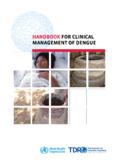Transcription of 2008-2013 Action Plan for the Global Strategy for the ...
1 Working in partnership to prevent and control the 4 noncommunicable diseases cardiovascular diseases, diabetes, cancers and chronic respiratory diseases and the 4 shared risk factors tobacco use, physical inactivity, unhealthy diets and the harmful use of alcohol. 2008-2013 Action Plan for the Global Strategy for the prevention and control of Noncommunicable Diseases tobacco use a s es r dise la s cu va chro nic io rd re sp ca ira to ry d isea ses l use of alcohol physical inactivity fu harm dia b es et rs nce ca unhealthy diets 2008-2013 Action Plan The six objectives of the 2008-2013 . Action Plan are: 1. To raise the priority accorded to noncommunicable disease in development work at Global and national levels, and to integrate prevention and control of such diseases into policies across all government departments 4.
2 To promote research for the prevention and control of noncommunicable diseases Objectives 2. 3. To establish and strengthen To promote interventions to national policies and plans for reduce the main shared modifiable the prevention and control of risk factors for noncommunicable noncommunicable diseases diseases : tobacco use, unhealthy diets, physical inactivity and harmful use of alcohol 5. 6. To promote partnerships for To monitor noncommunicable the prevention and control of diseases and their determinants noncommunicable diseases and evaluate progress at the national, regional and Global levels 01. 2008-2013 Action Plan WHO Library Cataloguing-in-Publication Data 2008-2013 Action plan for the Global Strategy for the prevention and control of noncommunicable diseases : prevent and control cardiovascular diseases, cancers, chronic respiratory diseases and diabetes.
3 1. Cardiovascular diseases - prevention and control . 2. Neoplasms - prevention and control . 3. Respiratory tract diseases - prevention and control . 4. Diabetes mellitus - prevention and control . 5. chronic diseases - prevention and control . 6. Strategic planning. 7. International cooperation. I. World Health Organization. II. Title: Action plan for the Global Strategy for the prevention and control of noncommunicable diseases. III. Title: Prevent and control cardiovascular diseases, cancers, chronic respiratory diseases and diabetes. ISBN 978 92 4 159741 8 (NLM classification: WT 500). World Health Organization 2008. All rights reserved. Publications of the World Health Organization can be obtained from WHO Press, World Health Organization, 20 Avenue Appia, 1211 Geneva 27, Switzerland (tel: +41 22 791 3264; fax: +41 22 791 4857; e-mail: ).
4 Requests for permission to reproduce or translate WHO publications . whether for sale or for noncommercial distribution should be addressed to WHO. Press, at the above address (fax: +41 22 791 4806; e-mail: The designations employed and the presentation of the material in this publication do not imply the expression of any opinion whatsoever on the part of the World Health Organization concerning the legal status of any country, territory, city or area or of its authorities, or concerning the delimitation of its frontiers or boundaries. Dotted lines on maps represent approximate border lines for which there may not yet be full agreement. The mention of specific companies or of certain manufacturers' products does not imply that they are endorsed or recommended by the World Health Organization in preference to others of a similar nature that are not mentioned.)
5 Errors and omissions excepted, the names of proprietary products are distinguished by initial capital letters. All reasonable precautions have been taken by the World Health Organization to verify the information contained in this publication. However, the published material is being distributed without warranty of any kind, either expressed or implied. The responsibility for the interpretation and use of the material lies with the reader. In no event shall the World Health Organization be liable for damages arising from its use. Printed by the WHO Document Production Services, Geneva, Switzerland Design and layout: FABRICA (Namyoung An). 02. 2008-2013 Action Plan for the Global Strategy for the prevention and control of Noncommunicable Diseases Foreword 05.
6 Introduction 07. 01. Action Plan for the Global Strategy for the prevention and control of Noncommunicable Diseases World Health Assembly document A61/8 (April 2008) 08. 02. Resolution of the Sixty-first World Health Assembly 2008: prevention and control of Noncommunicable Diseases: Implementation of the Global Strategy World Health Assembly resolution (May 2008) 30. 03. Global Strategy for the prevention and control of Noncommunicable Diseases World Health Assembly document A53/14 (March 2000) 32. 04. Resolution of the Fifty-third World Health Assembly 2000: prevention and control of Noncommunicable Diseases World Health Assembly resolution (May 2000) 40. 03.
7 2008-2013 Action Plan 04. Foreword Foreword We know what works, we know what it costs and we know that all countries are at risk. We have an Action Plan to avert millions of premature deaths and help promote a better quality of life for millions more.. TACKLING THE WORLD'S BIGGEST KILLERS AND ADDRESSING. KEY CHALLENGES TO Global DEVELOPMENT IN THE 21st CENTURY. Today, noncommunicable diseases (NCDs), mainly Working closely with Member States, WHO has, cardiovascular diseases, cancers, chronic respiratory therefore, developed this Action Plan to prevent NCDs diseases and diabetes represent a leading threat to human from occurring and to help the millions who are already health and development.
8 These four diseases are the affected to cope with these lifelong illnesses. This world's biggest killers, causing an estimated 35 million Action Plan, endorsed at the Sixty-first World Health deaths each year - 60% of all deaths globally - with 80% Assembly in May 2008, is based on the sound vision of in low- and middle-income countries. the Global Strategy for the prevention and control of Noncommunicable Diseases, endorsed at the Fifty-third These diseases are preventable. Up to 80% of heart World Health Assembly in May 2000. It also aims to build disease , stroke, and type 2 diabetes and over a third of on the WHO Framework Convention on Tobacco control cancers could be prevented by eliminating shared risk and the WHO Global Strategy on Diet, Physical Activity factors, mainly tobacco use, unhealthy diet, physical and Health.
9 The Action Plan provides Member States, inactivity and the harmful use of alcohol. WHO, and the international community with a roadmap Unless addressed, the mortality and disease burden from to establish and strengthen initiatives for the surveillance, these health problems will continue to increase. WHO prevention and management of NCDs. projects that, globally, NCD deaths will increase by 17% Furthermore, the Action Plan highlights the pressing over the next ten years. The greatest increase will be seen need to invest in NCD prevention as an integral part of in the African region (27%) and the Eastern Mediterranean sustainable socioeconomic development. NCD prevention region (25%).
10 The highest absolute number of deaths will is an all-government responsibility. Considerably more occur in the Western Pacific and South-East Asia regions. gains can be achieved by influencing policies of non-health We have the right vision and knowledge to address sectors than by health policies alone. All stakeholders will these problems. Proven cost-effective strategies exist need to intensify and harmonize their efforts to avert these to prevent and control this growing burden. However, preventable conditions and to save millions from suffering high-level commitment and concrete Action are often needlessly and dying prematurely. missing at the national level.













